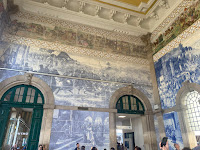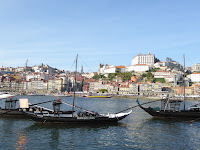 |
| Porto Fountain of Lions |
Porto
Arriving by train at Sao Bento train station is the easiest way into Porto.
Look around the entrance hall, it has amazing azulejos
(blue tiles that you will see throughout Portugal)
mosaics that depict key events in Portuguese history. In 2023
(and probably for years to follow),
Porto is building a new metro line connecting Sao Bento with points north.
It has created a lot of construction and disruption in front of the station, around
Praca da Liberdade, and along Avenida dos Aliados.
 |
| Sao Bento azulejos |
 |
| Sao Bento azulejos |
Porto is divided into the Lower Town and Ribeira (ree-BAY-rah) Waterfront and the
newer Upper Town (Center City). We stayed at the Hotel Infante Sagre, which is a beautiful historical hotel in a great location right in the middle of Upper Town,
surrounded by lots of restaurants and bars. Even if you don’t stay at this hotel,
visit the lobby and walk
up the stained glass stairs.
 |
| Ave of the Allies |
 |
| Carmelite Church |
Upper Town
Avenida dos Aliados (Avenue of the Allies) is in the heart of the upper city and has beautiful Art Nouveau and Art Deco buildings. A great sidewalk cafe for a drink along the Avenue is Cafe Restaurant Guarany. Note the Imperial McDonalds, which is reputed to be the most elegant in Europe. Walk along Rua da Fabrica to Praca de Gomes Teixeira and the Fountain of Lions, see the Carmelite church. The Prace de Lisboa Park and the Clerigos Church and Tower and great to explore.
 |
| Tiled Building |
 |
| View from Cathedral |
 |
| Fanciest McD's in Europe |
 |
| Fountain of Lions |
Nearby, the Livraria Lello (bookstore, built in 1906) is an Art Nouveau masterpiece; however, the line to enter can
stretch nearly a block - we chose not to sacrifice hours to see it. Just 5 yards down
Rua das Carmelitas (about as long as the waiting line) from Lello Bookstore
is Fernandes, Mattos & Ca, a beautiful store with a great selection of products made in Portugal (not trashy souvenirs,
but quality locally made products).
 |
| Henry the Navigator |
 |
| Praca Infante - view of river |
Lower Town
To explore the Lower Town, start at Sao Bento train station and take the pedestrian Rua das Flores,
lined with cafes and shops. It’s a great way to experience old town Porto.
This pedestrian street leads to Praca do Infante Dom Henrique (Henry the Navigator Square),
along with the Stock Exchange and Sao Francisco Church.
 |
| Rua das Flores cafes |
 |
| Rua das Flores |
 |
| Iron Balconies (Moorish influence) |
 |
| Rua das Flores |
 |
| Rua das Flores |
A couple blocks downhill is the Ribeira Waterfront, lined with homes and warehouses
for aging Port wine that
date back to the 15th century. The Ponte Dom Luis I bridge dominates the eastern end of the riverfront. It’s 150 tall, built in the 1880s by a protege of Gustave Eiffel, and has two levels that connect both the lower and upper towns of Porto to Gaia across the Douro river. Historically, wine could only be called “Port” if it was aged in Gaia. Walk the bottom bridge to Gaia for a great assortment of restaurants and shops for Port wine tasting. Look across the river for an amazing view of the Ribeira waterfront and the upper town above.
 |
| Ribeira |
 |
| Ribeira Waterfront |
 |
| Ponte Dom Luis I bridge |
 |
| View from Gaia |
 |
| Porto from Gaia |
 |
| Porto from Gaia |
Returning over the Ponte Dom Luis bridge to the Ribeira, take the long climb (or the funicular) up to Porto Cathedral and the Bishops Palace for amazing views of Porto. Note, it is a vigorous uphill walk.
 |
| Porto Cathedral |
 |
| Porto Cathedral Altar |
Tammy and I enjoyed Vinho Verde everywhere except Alentejo,
where they have many fine varietals to choose from.
See prior post for earlier destinations in Portugal…

No comments:
Post a Comment